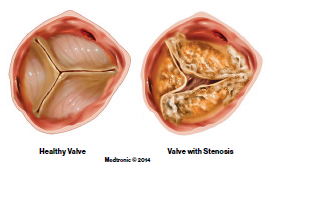THE HEART AND ITS VALVES
A healthy heart, which beats about 100,000 times a day,supplies the body with oxygen-rich blood. The heart is a muscular organ that has four chambers. Blood is pumped through the four chambers with the help of four heart valves— the aortic valve, the pulmonic valve, the mitral valve and
the tricuspid valve. During an average lifetime, these valves will open and close over two billion times.
Heart valves open when the heart pumps to allow blood to flow. They close quickly between heartbeats to make sure the blood does not flow backward. Any trouble with this normal flow will make it hard for the heart to pump the blood where it needs to go.
The aortic valve controls the flow of blood as it exits the heart and is pumped to the rest of the body.


VALVE DISORDERS
Sometimes, these hardworking valves can run into problems that can cause issues with blood flow and threaten overall health.
Stenosis, more specifically aortic stenosis (AS), is a narrowing of the aortic valve opening. It can be caused by age, genetic predisposition, rheumatic fever, radiation and/or buildup on the leaflets of calcium, cholesterol (fat), etc. This results in stiff valve leaflets that don’t move easily or open fully.
This reduces the pumping ability of the heart to push blood through the aortic valve to your body. Left untreated, severe AS can lead to heart failure or even sudden death.
Regurgitation happens when the valve has become damaged or worn out and blood is able to leak backwards.This makes the heart work harder to circulate the blood, and, if left untreated, can result in heart failure.
Symptoms of Aortic Stenosis
• Shortness of breath
• Dizziness or fainting
• Chest pain
• Feeling tired or fatigued
• Swelling in your legs
Treatment for Severe Aortic Stenosis
Unfortunately, though there are many medications available to treat other heart conditions, there is no drug therapy to cure aortic stenosis.
For severe aortic stenosis, your doctor may prescribe medicine to make you feel better in the short term, but ultimately you will require intervention.
Causes of Aortic Stenosis
• Age
• Genetic predisposition
• Rheumatic heart disease
• Radiation exposure
SURGICAL AORTIC VALVE REPLACEMENT(SAVR)
Surgical aortic valve replacement has been the standard of treatment for aortic stenosis for many years.The procedure may be performed through an open surgery or a minimally invasive approach done using a smaller cut. The patient’s breathing and circulation are transferred to a heart-lung machine during the surgery.Once the site is accessed, the surgeon will remove the diseased valve and implant an artificial valve. There are many valves available on the market. These artificial valves are man-made from synthetic materials(mechanical), constructed from animal tissue(biological), or some combination of the two. You may be in the hospital for more than a week.


